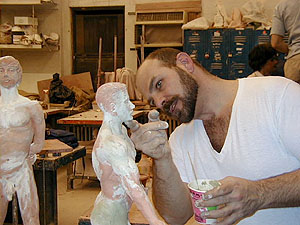© CJ Mingolelli,
2001-2010
Site Designed by
 | |
| | Finish Applied to Sculptures |
 |
 |
|
Sculptures (Gianni and Donnie) being touched up with wood putty and plaster to conceal cracks from the firing. Once complete, finish patinas are applied.
|
Finishing is exciting - it is the end of the creation, and soon the artist will rest and reflect.
Most times, I have a concept of what effect I want to achieve with my sculpture when I apply a finish. The sculpture already lends itself to some particular color or texture in most cases, and that is what I see and employ when I chose their final look and feel.
Once a sculpture is fired, it will usually need some touching up. This is usually a crack or a break. For breaks, I use epoxy glues and epoxy putty depending upon the severity of the break. Once the epoxy is cured, it's time to for some cosmetic touch ups with wood putty or sometimes plaster. This will fill in the leftover cracks and abrasions.
After the touch up phase, it's time for paint. I chose paints (oil based and water based acrylics) over glazes because they're more fun, and they reveal depth better than basic glazing. Glazing also requires a second firing in the kiln, and would not allow cosmetic touch-ups to be done as readily and easily. I also prefer paints because they reveal as the process takes it's course. Using paint is called "patinating" because it alludes a natural effect of aging once the finish is applied.
I also use a number of products in place of paint - shoe polishes with wax bases, dry paint pigments, even egg washes. Many of these tricks of the trade are shared secrets among sculptors. I achieved an interesting effect by burning the paint after it was applied, which gave the sculpture a rugged ancient texture.
Being creative is the best approach. If I wanted to change the sculpture after it was complete, it was as easy as starting over. Experimenting with these finishes is a great challenge, and also a great reward once a technique is achieved.
| | |
